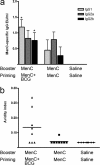Concomitant administration of Mycobacterium bovis BCG with the meningococcal C conjugate vaccine to neonatal mice enhances antibody response and protective efficacy
- PMID: 21900528
- PMCID: PMC3209029
- DOI: 10.1128/CVI.05247-11
Concomitant administration of Mycobacterium bovis BCG with the meningococcal C conjugate vaccine to neonatal mice enhances antibody response and protective efficacy
Abstract
Mycobacterium bovis BCG is administered to human neonates in many countries worldwide. The objective of the study was to assess if BCG could act as an adjuvant for polysaccharide-protein conjugate vaccines in newborns and thereby induce protective immunity against encapsulated bacteria in early infancy when susceptibility is high. We assessed whether BCG could enhance immune responses to a meningococcal C (MenC) conjugate vaccine, MenC-CRM(197), in mice primed as neonates, broaden the antibody response from a dominant IgG1 toward a mixed IgG1 and IgG2a/IgG2b response, and increase protective efficacy, as measured by serum bactericidal activity (SBA). Two-week-old mice were primed subcutaneously (s.c.) with MenC-CRM(197). BCG was administered concomitantly, a day or a week before MenC-CRM(197). An adjuvant effect of BCG was observed only when it was given concomitantly with MenC-CRM(197), with increased IgG response (P = 0.002) and SBA (8-fold) after a second immunization with MenC-CRM(197) without BCG, indicating increased T-cell help. In neonatal mice (1 week old) primed s.c. with MenC-CRM(197) together with BCG, MenC-polysaccharide (PS)-specific IgG was enhanced compared to MenC-CRM(197) alone (P = 0.0015). Sixteen days after the second immunization with MenC-CRM(197), increased IgG (P < 0.05), IgG1 (P < 0.05), IgG2a (P = 0.06), and IgG2b (P < 0.05) were observed, and only mice primed with MenC-CRM(197) plus BCG showed affinity maturation and detectable SBA (SBA > 128). Thus, vaccination with a meningococcal conjugate vaccine (and possibly with other conjugates) may benefit from concomitant administration of BCG in the neonatal period to accelerate and enhance production of protective antibodies, compared to the current infant administration of conjugate which follows BCG vaccination at birth.
Figures



Similar articles
-
Neonatal immune response and serum bactericidal activity induced by a meningococcal conjugate vaccine is enhanced by LT-K63 and CpG2006.Vaccine. 2008 Aug 18;26(35):4557-62. doi: 10.1016/j.vaccine.2008.05.083. Epub 2008 Jun 17. Vaccine. 2008. PMID: 18597905
-
Randomized Trial to Compare the Immunogenicity and Safety of a CRM or TT Conjugated Quadrivalent Meningococcal Vaccine in Teenagers who Received a CRM or TT Conjugated Serogroup C Vaccine at Preschool Age.Pediatr Infect Dis J. 2015 Aug;34(8):865-74. doi: 10.1097/INF.0000000000000750. Pediatr Infect Dis J. 2015. PMID: 26075813 Clinical Trial.
-
A randomized, multicenter, open-label clinical trial to assess the immunogenicity of a meningococcal C vaccine booster dose administered to children aged 14 to 18 months.Pediatr Infect Dis J. 2010 Feb;29(2):148-52. doi: 10.1097/INF.0b013e3181b9a831. Pediatr Infect Dis J. 2010. PMID: 19927040 Clinical Trial.
-
Persistence of serum bactericidal antibody one year after a booster dose of either a glycoconjugate or a plain polysaccharide vaccine against serogroup C Neisseria meningitidis given to adolescents previously immunized with a glycoconjugate vaccine.Pediatr Infect Dis J. 2011 Nov;30(11):e203-8. doi: 10.1097/INF.0b013e318224fb14. Pediatr Infect Dis J. 2011. PMID: 21673612 Clinical Trial.
-
Immunogenicity of routinely used childhood vaccines when coadministered with the 10-valent pneumococcal non-typeable Haemophilus influenzae protein D conjugate vaccine (PHiD-CV).Pediatr Infect Dis J. 2009 Apr;28(4 Suppl):S97-S108. doi: 10.1097/INF.0b013e318199f61b. Pediatr Infect Dis J. 2009. PMID: 19325452 Review.
Cited by
-
Ontogeny of early life immunity.Trends Immunol. 2014 Jul;35(7):299-310. doi: 10.1016/j.it.2014.04.007. Epub 2014 May 28. Trends Immunol. 2014. PMID: 24880460 Free PMC article. Review.
-
The BCG Moreau Vaccine Upregulates In Vitro the Expression of TLR4, B7-1, Dectin-1 and EP2 on Human Monocytes.Vaccines (Basel). 2022 Dec 30;11(1):86. doi: 10.3390/vaccines11010086. Vaccines (Basel). 2022. PMID: 36679931 Free PMC article.
-
Factors contributing to the immunogenicity of meningococcal conjugate vaccines.Hum Vaccin Immunother. 2016 Jul 2;12(7):1808-24. doi: 10.1080/21645515.2016.1153206. Epub 2016 Mar 2. Hum Vaccin Immunother. 2016. PMID: 26934310 Free PMC article. Review.
-
Adjuvant Effect of Bacille Calmette-Guérin on Hepatitis B Vaccine Immunogenicity in the Preterm and Term Newborn.Front Immunol. 2018 Jan 24;9:29. doi: 10.3389/fimmu.2018.00029. eCollection 2018. Front Immunol. 2018. PMID: 29416539 Free PMC article.
-
BCG vaccination-induced emergency granulopoiesis provides rapid protection from neonatal sepsis.Sci Transl Med. 2020 May 6;12(542):eaax4517. doi: 10.1126/scitranslmed.aax4517. Sci Transl Med. 2020. PMID: 32376769 Free PMC article.
References
-
- Andersen P., Doherty T. M. 2005. The success and failure of BCG—implications for a novel tuberculosis vaccine. Nat. Rev. Microbiol. 3:656–662 - PubMed
-
- Avery D. T., Bryant V. L., Ma C. S., de Waal Malefyt R., Tangye S. G. 2008. IL-21-induced isotype switching to IgG and IgA by human naive B cells is differentially regulated by IL-4. J. Immunol. 181:1767–1779 - PubMed
-
- Bjarnarson S. P., et al. 2005. The advantage of mucosal immunization for polysaccharide-specific memory responses in early life. Eur. J. Immunol. 35:1037–1045 - PubMed
-
- Borrow R., Balmer P., Miller E. 2005. Meningococcal surrogates of protection—serum bactericidal antibody activity. Vaccine 23:2222–2227 - PubMed
Publication types
MeSH terms
Substances
LinkOut - more resources
Full Text Sources
Medical

